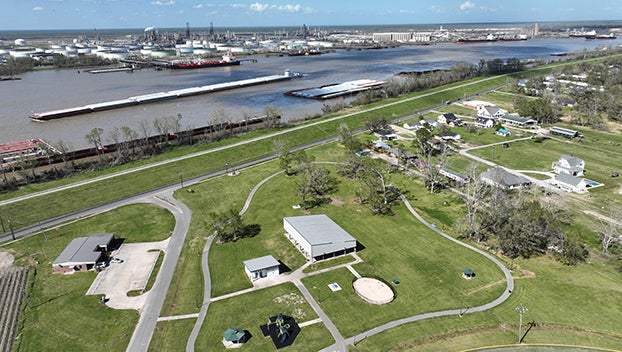Court ruling returns Wallace land to residential zoning
Published 5:57 pm Friday, August 4, 2023

- The West Bank of St. John Parish is seen from an aerial view with Garyville visible on the opposite side of the river. (Photo credit: Louisiana Trust for Historic Preservation)
|
Getting your Trinity Audio player ready...
|
WALLACE — In a ruling on August 4, Judge J. Sterling Snowdy declared a contested 1990 ordinance null and void, returning a tract of farmland in Wallace from industrial use back to its original residential zoning.
This ruling has major implications for the construction of Greenfield Louisiana’s proposed grain terminal.
In his ruling, Snowdy referenced the fact that the Parish Council passed an amended version of the ordinance in April 1990 without first submitting the amended text to the Planning Commission for review and recommendation.
Sisters Jo and Joy Banner, founders of The Descendants Project, have been fighting against the Greenfield development since 2021. In a lawsuit filed against St. John Parish, the Banner sisters argued that residents of Wallace are faced with the development of a grain elevator in their quiet community as a direct result of an injustice that happened more than three decades ago.
Ordinance 90-27 rezoned a tract of land from residential to industrial use in 1990. Six years later, then Parish President Lester Millet Jr. was sentenced to 57 months in prison after being convicted of extortion, money laundering and violation of the Travel Act in connection to his efforts to assist Formosa Plastics Group in locating a rayon pump facility in Wallace. At the time, the Court of Appeals cited that these efforts included convincing nearby property owners, through illegal means, to convey their property to Formosa.
Plans for the facility eventually fell through, but not before the Wallace tract was rezoned for industrial use in April 1990, the same month Formosa completed the purchase of the land. The rezoning has remained on the books, and the land has since been used for farming sugarcane.
Today’s ruling declares Ordinance 90-27 null and void ab initio, meaning it was null from the beginning and never had any legal effect.
While the lawsuit centered on Millet’s alleged corruption, Snowdy noted that plaintiffs failed to demonstrate Millet’s fraudulent acts extended to the rezoning of Wallace farmland. According to Snowdy, plaintiffs would need to demonstrate that Millet obtained something of economic value, directly or indirectly, through the enactment of Ordinance 90-27.
Instead, Ordinance 90-27 was declared null based on a procedural concern.
The St. John the Baptist Parish Council voted unanimously, with one recusal, to enact Ordinance 90-27 on April 19, 1990. Immediately prior to voting on the ordinance’s enactment, Councilman Haston Lewis introduced an amendment that would place a 300-foot I-1 buffer wherever an I-3 district buffers an R-1 residential district.
The Parish Council voted to enact the amended Ordinance 90-27. Minutes from the April 19, 1990 meeting indicate that Councilman Lewis’ amendment was added without being formally submitted to the Planning Commission for review and recommendation as required by parish policy.
“In summarizing the judgment above, the court grants summary judgment to Plaintiffs and declares Ordinance 90-27 null and void ab initio due to the council’s failure to submit Councilman Lewis’ amendment, which changed the zoning classification considered by the planning commission, to the planning commission for review and recommendation prior to the enactment,” Snowdy wrote. “Notable, Plaintiffs request a plethora of relief. However, the relief grant is limited to the declaration that ordinance 90–27 is null and void ab initio.”
Jo and Joy Banner issued the following statement in response to the ruling:
“We thank the Court for ruling that the Greenfield site in Wallace be returned to residential zoning, which will prevent the continued development of environmentally devastating projects like the proposed Greenfield Terminal. We are hopeful this ruling puts an end to the illegal 30-year-old rezoning ordinance that categorized the historic St. John the Baptist Parish in Louisiana as an industrial area. Judge Snowdy and the 40th District Court have soundly rejected the notion that the rich history of this region and the environment and health of our community should be disregarded in favor of corporate greed.”
L’OBSERVATEUR has reached out to Greenfield Louisiana for comment on today’s ruling.
On May 9, the National Trust for Historic Preservation named the 11-mile corridor along the Mississippi River on the West Bank of St. John Parish as one of the “11 Most Endangered Historic Places for 2023.” The tract of land is also under consideration to be designated a National Historic Landmark.
When the West Bank was named to the Endangered Historic Places list, organizers of the Greenfield project shared a desire to co-exist with historic preservation and responsible economic revitalization.
Greenfield has set aside land and funding for the purpose of preserving and protecting West Bank history and to “tell a more complete story that connects to Louisiana’s historic tourism infrastructure.” According to a Greenfield spokesperson, a community-based board funded through the West Bank Prospers Foundation was created to guide these efforts.
Update – Greenfield Louisiana issued the following statement:
“On Friday, the 40th Judicial District Court for St. John the Baptist Parish ruled that a procedural issue with the original buffer zone established in 1990 has affected the zoning on Greenfield’s proposed grain export facility site. While we are disappointed with this outcome, we remain fully committed to resolving this issue and moving forward with our plans to build the grain export facility, including by proceeding with the ongoing permitting process.
We appreciate the overwhelming support from the Wallace community and the extended West Bank region, and we firmly believe that these procedural hurdles will be overcome. Our dedication to creating economic opportunities and sustainable growth remains unwavering.
Greenfield remains committed to the West Bank community and will keep our neighbors informed of progress and updates.”



